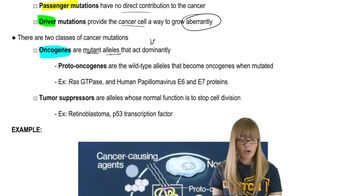Table of contents
- 1. Introduction to Genetics51m
- 2. Mendel's Laws of Inheritance3h 37m
- 3. Extensions to Mendelian Inheritance2h 41m
- 4. Genetic Mapping and Linkage2h 28m
- 5. Genetics of Bacteria and Viruses1h 21m
- 6. Chromosomal Variation1h 48m
- 7. DNA and Chromosome Structure56m
- 8. DNA Replication1h 10m
- 9. Mitosis and Meiosis1h 34m
- 10. Transcription1h 0m
- 11. Translation58m
- 12. Gene Regulation in Prokaryotes1h 19m
- 13. Gene Regulation in Eukaryotes44m
- 14. Genetic Control of Development44m
- 15. Genomes and Genomics1h 50m
- 16. Transposable Elements47m
- 17. Mutation, Repair, and Recombination1h 6m
- 18. Molecular Genetic Tools19m
- 19. Cancer Genetics29m
- 20. Quantitative Genetics1h 26m
- 21. Population Genetics50m
- 22. Evolutionary Genetics29m
19. Cancer Genetics
Cancer Mutations
Problem 10
Textbook Question
Describe the steps by which the TP53 gene responds to DNA damage and/or cellular stress to promote cell-cycle arrest and apoptosis. Given that TP53 is a recessive gene and is not located on the X chromosome, why would people who inherit just one mutant copy of a recessive tumor-suppressor gene be at higher risk of developing cancer than those without the recessive gene?
 Verified step by step guidance
Verified step by step guidance1
Identify the role of the TP53 gene: TP53 is a tumor suppressor gene that plays a critical role in regulating the cell cycle and preventing cancer by responding to DNA damage and cellular stress.
Explain the mechanism of TP53 activation: Upon DNA damage or cellular stress, TP53 is activated and functions as a transcription factor to induce the expression of genes involved in cell-cycle arrest, DNA repair, and apoptosis.
Describe the process of cell-cycle arrest: TP53 activation leads to the transcription of the CDKN1A gene, which encodes the p21 protein. p21 inhibits cyclin-dependent kinases (CDKs), halting the cell cycle at the G1/S checkpoint to allow for DNA repair.
Outline the induction of apoptosis: If DNA damage is irreparable, TP53 promotes apoptosis by activating pro-apoptotic genes such as BAX, PUMA, and NOXA, leading to programmed cell death.
Discuss the genetic risk of inheriting a mutant TP53 allele: Although TP53 is recessive, individuals with one mutant allele (heterozygotes) are at higher risk of cancer because the loss of the second functional allele (loss of heterozygosity) can lead to a complete loss of TP53 function, removing its tumor-suppressing capabilities.
Recommended similar problem, with video answer:
 Verified Solution
Verified SolutionThis video solution was recommended by our tutors as helpful for the problem above
Video duration:
1mPlay a video:
Was this helpful?
Key Concepts
Here are the essential concepts you must grasp in order to answer the question correctly.
TP53 Gene Function
The TP53 gene encodes the p53 protein, which plays a critical role in regulating the cell cycle and maintaining genomic stability. In response to DNA damage or cellular stress, p53 is activated to induce cell-cycle arrest, allowing for DNA repair, or to trigger apoptosis if the damage is irreparable. This function is essential for preventing the proliferation of damaged cells, thereby acting as a tumor suppressor.
Recommended video:
Guided course

Functional Genomics
Recessive Genes and Tumor Suppression
Recessive genes require two copies of the mutant allele to manifest their effects. In the case of tumor suppressor genes like TP53, inheriting one mutant copy does not immediately lead to cancer, but it predisposes individuals to cancer because the normal allele can still produce functional p53. However, if the remaining normal allele is lost or mutated, the protective function is compromised, increasing cancer risk.
Recommended video:
Guided course

Mapping Genes
Cell Cycle Regulation and Apoptosis
The cell cycle is a series of phases that a cell goes through to divide and replicate. p53 regulates this process by halting the cycle in response to stress signals, allowing for repair mechanisms to function. If the damage is too severe, p53 can initiate apoptosis, a programmed cell death pathway, to eliminate potentially cancerous cells, thus preventing tumor development.
Recommended video:
Guided course

Bacteriophage Life Cycle

 4:50m
4:50mWatch next
Master Cancer Mutations with a bite sized video explanation from Kylia Goodner
Start learningRelated Videos
Related Practice


